This is a Veteran Owned site

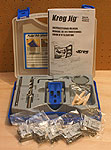 |
The Kreg R3 Kit includes everything you need to get started and not a lot of extra screws you are not likely to use. Click image to enlarge |
Kreg R3 Pocket Hole Joinery Kit
Getting started right – and cheap
Text & Photos by Tom Hintz
Posted – 11-06-2006
The 1986 invention of Craig Sommerfeld, the Kreg Pocket Hole system quickly became a phenomenon in woodworking. Though veteran woodworkers quickly embraced pocket hole technology, it has been a boon to new woodworkers because of its simplicity and the remarkably strong joints the Kreg Pocket Hole system makes available to them. The very reasonable cost of the various Kreg Pocket Hole kits makes this one of the most cost-effective joinery systems available.
The Kreg R3 Kit
While the Kreg R3 Pocket Hole Kit may have been designed with the do-it-yourselfer crowd in mind, the capabilities of is components make it an exceptional starter set for woodworkers as well.
The Kreg R3 Jig Kit includes the R3 drilling jig, Kreg step drill, stop collar with hex wrench, snap-in adapter for using the Kreg Face Clamp (not included), 6” square drive bit (quick connect shank), a bag of (5) pocket hole plugs and five bags (10 per bag) of various pocket screws. Also included are a fully illustrated instruction manual to help get you started and a handy carry case.
Kreg R3 Jig Body
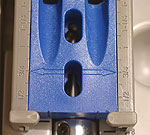 |
 |
The R3 jig body (left) has a pair of sliders that are set to the markings matching the thickness of the wood. It couldn't be easier. |
|
At the heart of the Kreg R3 Jig Kit is a new jig block design that can be used with clamps you are likely to already have or one the Kreg Face Clamp variations. During this evaluation I used the R3 jig block with both type of clamps without issue.
The Kreg R3 Jig Kit jig block has graduated sliding stops on either side that calibrate it to drill pilot holes that are properly centered in wood from ½” to 1 ½”-thick. Setting the Kreg R3 Jig Kit jig block up is as easy as matching the thickness settings.
The carry case insert has markings on either side of the drill bit storage slot for setting the stop collar for the wood thickness being used.
The sliding adjusters on the Kreg R3 Jig Kit jig block have short arms at their base that hook over the edge of the wood to automatically locate the jig correctly. All the user has to do is place the jig block where the screw holes are to be drilled and clamp it in place.
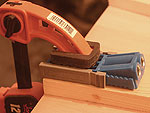 |
 |
The R3 drilling jig can be clamped with any good clamp you may already have (left) or the special Kreg Face Clamp (right) that is also designed to hold the pieces for assembly.
Click images to enlarge |
|
A chart applied to the inside of the carry case cover has all the information needed for setting the stop collar manually and choosing the proper length screws for the thickness of wood being used.
In the Shop
Once you have used the Kreg Pocket Hole Joinery System you will understand why this part of the review is so short. This system quite literally works as advertised – very easily. If you follow the simple instructions, making pocket hole joints is simple and fast. Your biggest chores are cutting the wood to the right length and making sure that the ends are square.
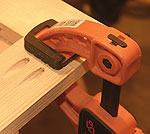 |
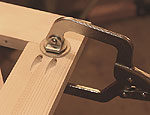 |
A common clamp can be used to hold the pieces for assembly (left) but the Kreg Face Clamp (right) is designed for the task and does work better. Click images to enlarge |
|
The most likely part of the procedure to cause problems is clamping the pieces together before driving the screws in place. It is important that the pieces be clamped solidly with their surfaces flush. Do that and the surfaces will remain flush after driving the screws with very little (if any) sanding required. The Kreg Face Clamps do a very good job of holding the pieces correctly but you can use many types of clamps to accomplish the same thing. Clamps with soft faces benefit from adding a piece of flat scrap wood to the top and bottom of the joint and placing the clamp over them to help keep the pieces aligned.
The Kreg R3 Jig Kit jig block has two guide bushings that automatically space two screws in pieces around 2”-wide and larger. However, indicator lines on the end of the jig block make it easy to line it up to drill a single hole in narrower stock. Because the pilot holes are only drilled in one piece of the joint, there is no worry about aligning the pilot hole other than getting them reasonably centered on that piece.
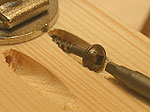 |
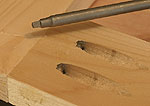 |
The R3 kit includes the square drive bit (left) for driving the Kreg screws. (right) Producing flush, very strong joints is remarkably easy with the Kreg R3 Kit. Click images to enlarge |
|
After having used the Kreg K3 Master Kit with its more sophisticated drilling block/clamping system, I was a little concerned about how easy the R3 version would be to use in common situations. That concern proved to be unfounded. The R3 guide block is very easy to use and stable when secured with a plain speed clamp.
The special Kreg-designed and manufactured step drill has a ½”-diameter shank and makes short work of boring the pilot holes in anything from pine to oak. I have been using Kreg pocket screws for years and have never used anything but a 14.4v Bosch cordless drill to bore the holes and drive the pocket screws. I never felt lacking for power or control.
Conclusions
The Kreg R3 Jig Kit is a very good, reasonably priced way for new or veteran woodworkers to get into this very useful form of joinery. At first, I thought the small supply of screws was a detriment but since most woodworkers use only one or two sizes for the majority of their work, saving that expense in the Kreg R3 Jig Kit makes sense. I’d rather save those dollars on the kit and apply that cash towards buying a larger supply of the screws I will actually use.
With a street price of $39.99 (11-6-2006) the Kreg R3 Jig Kit is as economical as it is versatile. If you have been considering trying pocket hole joinery, the Kreg R3 Jig Kit is an easy to use, cost-effective way to get started.
Have a comment on this review? –Email Me!
All written, photographic and drawn materials are property of and copyright by NewWoodworker.com LLC 2000-2019. Materials may not be used in any way without the written permission of the owner.

